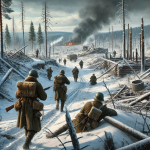The Continuation War (1941-1944) was the second major conflict between Finland and the Soviet Union during World War II. Following the Winter War (1939-1940), Finland sought to reclaim the territory it had lost to the Soviet Union in the Moscow Peace Treaty. When Nazi Germany invaded the Soviet Union in June 1941, Finland joined forces with Germany, viewing this alliance as an opportunity to recover its lost lands and secure its independence. Although Finland and Germany shared a common enemy, Finland maintained a degree of independence in its objectives. For those studying for the Finnish citizenship test, understanding the Continuation War offers insight into Finland’s complex position during World War II, balancing alliances and autonomy.
Background: The Path to the Continuation War
The Winter War had ended in March 1940 with the Moscow Peace Treaty, which required Finland to cede approximately 11% of its territory to the Soviet Union. This loss, which included significant parts of Karelia, displaced around 400,000 Finns from their homes. The treaty left Finland weakened and resentful, with many Finns eager to regain their lost lands.
In June 1941, Nazi Germany launched Operation Barbarossa, a massive invasion of the Soviet Union. Seeing an opportunity to reclaim its territory and prevent further Soviet expansion, Finland aligned itself with Germany. However, unlike Germany, Finland’s primary aim was not ideological but territorial—focused on securing its borders rather than furthering the broader goals of Nazi Germany.
Finland’s Alliance with Germany
Although Finland allied with Germany during the Continuation War, it maintained a careful diplomatic stance, distinguishing its objectives from those of Nazi Germany.
- Limited Partnership with Germany: Finland referred to its role in the war as a “co-belligerency” with Germany rather than a formal alliance. Finland sought to recover the territory lost in the Winter War and strengthen its defense against future Soviet aggression, but it was not committed to Germany’s ideological or territorial aims. This partnership enabled Finland to receive crucial military supplies and support while preserving a degree of autonomy.
- German Military Assistance and Supplies: Germany provided Finland with military supplies, arms, and logistical support. German troops were stationed in northern Finland, defending Finnish territory and launching operations against the Soviet Union from Finnish soil. German support strengthened Finland’s military position and allowed Finnish forces to focus on their own objectives without fully integrating into the German military strategy.
- Finnish Control of War Aims: Finland avoided participating in certain German operations, particularly those targeting civilians and involving anti-Semitic policies. Finnish leaders, including President Risto Ryti and Marshal Carl Gustaf Emil Mannerheim, emphasized that Finland’s goal was to defend its sovereignty and reclaim lost territory. Despite the alliance, Finland pursued its own interests and distanced itself from Nazi ideology.
Key Events and Battles of the Continuation War
The Continuation War included significant battles and territorial gains, with Finnish forces advancing deep into Soviet territory.
- Operation Barbarossa and Finland’s Entry into the War: Finland entered the Continuation War on June 25, 1941, following Soviet airstrikes on Finnish cities. Finnish forces launched an offensive to retake Karelia and other lost regions, advancing into Soviet territory. By the end of 1941, Finland had regained the land it lost in the Winter War and occupied additional areas in Soviet Karelia.
- Siege of Leningrad: Finnish troops, positioned north of Leningrad (present-day St. Petersburg), played a role in the Siege of Leningrad, one of the longest and most devastating sieges of World War II. Although Finland maintained its positions near Leningrad, it avoided direct involvement in the siege, holding back from advancing further as it had already secured its primary territorial objectives.
- Stalemate on the Eastern Front: By 1942, the Finnish military focused on defending its positions rather than advancing further into Soviet territory. The war became a stalemate, with Finnish and Soviet forces holding their lines across a fortified front. Finland maintained a defensive stance, hoping to negotiate a favorable peace settlement that would secure its regained territory.
- Shift in the War’s Momentum (1943-1944): The Soviet Union gradually gained strength and momentum on the Eastern Front. In 1944, Soviet forces launched a major offensive against Finland, breaking through the Finnish lines and forcing Finland into a defensive retreat. The Battle of Tali-Ihantala, fought in June and July 1944, became the largest battle ever fought in the Nordic region, with Finnish forces managing to halt the Soviet advance temporarily.
The Moscow Armistice and the End of the Continuation War
As the Soviet Union’s victory in World War II became inevitable, Finland faced increasing pressure to exit the war and negotiate peace.
- The Moscow Armistice (September 1944): On September 19, 1944, Finland signed an armistice with the Soviet Union, effectively ending the Continuation War. Under the terms of the armistice, Finland agreed to return to the borders established in the Moscow Peace Treaty of 1940, surrender additional territory in Lapland, pay reparations to the Soviet Union, and expel all German troops from its territory.
- The Lapland War (1944-1945): Following the armistice, Finland was required to drive German forces out of its territory, leading to a separate conflict known as the Lapland War. Finnish troops fought German forces in northern Finland, ultimately expelling them by April 1945. This marked the end of Finland’s involvement in World War II.
Consequences of the Continuation War
The Continuation War had lasting consequences for Finland’s territory, economy, and foreign policy.
- Territorial and Economic Losses: As part of the armistice, Finland ceded additional territory, including parts of Karelia, Salla, and the Petsamo region, which provided access to the Arctic Ocean. These territorial losses resulted in the displacement of around 420,000 Finns and a significant blow to Finland’s economy. Finland also faced substantial reparations payments to the Soviet Union, which strained its postwar recovery.
- Political Consequences and Relations with the Soviet Union: Finland’s alliance with Germany had damaged its diplomatic standing, and the terms of the armistice placed Finland under Soviet influence. Finland adopted a policy of neutrality and careful diplomacy with the Soviet Union, a stance that became known as “Finlandization.” This policy allowed Finland to retain its independence and democratic system while avoiding actions that might provoke Soviet intervention.
- Impact on Finnish Society and Identity: The Continuation War reinforced the spirit of sisu, a Finnish concept of perseverance and resilience, as Finns demonstrated their determination to defend their sovereignty. The experience of the Winter War and Continuation War shaped Finnish identity, fostering a sense of unity and resilience in the face of hardship.
- Legacy of Neutrality and Non-Alignment: After World War II, Finland pursued a policy of non-alignment, balancing its relationships with both Western and Eastern powers. This policy allowed Finland to navigate the Cold War without joining military alliances, preserving its independence and autonomy. The legacy of neutrality remains a defining feature of Finland’s foreign policy.
Conclusion: The Continuation War’s Role in Finnish History
The Continuation War was a complex chapter in Finnish history, defined by Finland’s efforts to reclaim its territory, maintain its sovereignty, and navigate the pressures of World War II. While the alliance with Germany helped Finland resist Soviet aggression, it also brought significant challenges and long-term consequences. The war ultimately reinforced Finland’s commitment to independence and shaped its policy of neutrality during the Cold War.
For those studying for the Finnish citizenship test, understanding the Continuation War highlights Finland’s strategic resilience and diplomatic skill. The legacy of the Continuation War and the subsequent policy of neutrality reflect Finland’s enduring values of sovereignty, self-determination, and peace.


